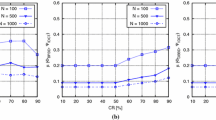Abstract
If electromagnetic (EM) waves emanating from a wireless device during a cryptographic computation leak sufficient information, it may be possible for an attacker to reconstruct the secret key. Despite the complexities of a Java-based PDA device, this paper presents a new phase based technique for aligning EM frames for subsequent time based DEMA. The proposed technique involves: fast Fourier transform, phase-substitution, inverse fast Fourier transform and time based DEMA. Results are repeatable over several different secret keys. Unlike previous research the new technique does not require perfect alignment of EM frames, and demonstrates robustness in the presence of a complex embedded system (including cache misses, operating system events, etc.) with random delays as well as random operations. This research is important for future wireless and complex embedded systems where security is crucial.
Similar content being viewed by others
References
Kocher P, Jaffe J, Jun B (1999) Differential power analysis. In: Crypto’99. Lecture notes in computer science, vol 1666. Springer, Berlin, pp 388–397
Brian Gladman Dr (2003) A specification for Rijndael, the AES algorithm, at fp.gladman.plus.com/cryptography_technology/rijndael/aes.spec.311.pdf
Agrawal D et al (2002) The EM side-channel(s). In: CHES 2002, pp 29–45
Gandolfi K et al. (2001) Electromagnetic analysis: concrete results. In: CHES 2001. Lecture notes in computer science, vol 2162. Springer, Berlin, pp 251–261
Agrawal D et al. The EM side-channel…methodologies. http://www.research.ibm.com/intsec/emf.html
Itoh K et al (2002) DPA countermeasure based on the masking method. In: Lecture notes in computer science, vol 2288. Springer, Berlin, pp 440–456
Messerges T (2000) Using 2nd order power analysis to attack DPA resistant software. In: Lecture notes in computer science, vol 1965. Springer, Berlin, pp 238–251
Ravi S et al (2002) Securing wireless data: system architecture challenges. In: ISSS, pp 195–200
Waddle J, Wagner D (2004) Towards efficient second-order power analysis. In: CHES 2004. Lecture notes in computer science, vol 3156. Springer, Berlin, pp 1–15
Agrawal D et al. (2003) Advances in side-channel cryptanalysis EM analysis and template attacks. RSA Cryptobytes 16(1):20–32
Agrawal D et al (2003) Power, EM and all that: is your crypto device really secure? In: Presentation ECC workshop. http://www.cacr.math.uwaterloo.ca/conferences/2003/ecc2003/rohatgi.ppt
Messerges T (2001) Securing the Rijndael finalists against power analysis attacks. In: Lecture notes in computer science, vol 1978. Springer, Berlin, pp 150–164
Gebotys C, Ho S, Tiu A (2005) EM analysis of Rijndael and ECC on a wireless Java-based PDA. In: Proceedings of CHES 2005. Lecture notes in computer science, vol 3659. Springer, Berlin, pp 250–265
Homma N et al (2006) High-resolution side-channel attack using phase-based waveform matching. In: Proceedings of CHES 2006. Lecture notes in computer science. Springer, Berlin (to appear)
Quisquater J-J et al (2000) A new tool for non-intrusive analysis of smartcards based on EM emissions. In: Rump session, Eurocrypt
Brian Gladman Dr (2003) A specification for Rijndael, the AES algorithm. fp.gladman.plus.com/cryptography_technology/rijndael/aes.spec.311.pdf
Chari S et al (1999) Towards sound approaches to counteract power-analysis attacks. In: Lecture notes in computer science, vol 1666. Springer, Berlin, pp 398–412
Goubin L, Patarin J (2001) DES and differential power analysis—the duplication method. In: CHES, pp 158–172
Golic J (2002) Multiplicative masking and power analysis of Rijndael. In: CHES, pp 1–10
Oren Y, Shamir A. Power analysis of RFID tags. http://www.wisdom.weizmann.ac.il/~yossio/rfid2006
Gebotys C, White B (2006) Methodology for attack on a Java-based PDA. In: Proceedings of IEEE/ACM CODES+ISSS, Seoul, S. Korea, pp 94–99
Mangard S, Oswald E, Popp T (2007) Power analysis attacks revealing the secrets of smart cards. Springer, Berlin
Author information
Authors and Affiliations
Corresponding author
Rights and permissions
About this article
Cite this article
Gebotys, C., White, B.A. EM alignment using phase for secure embedded systems. Des Autom Embed Syst 12, 185–206 (2008). https://doi.org/10.1007/s10617-008-9016-0
Received:
Accepted:
Published:
Issue Date:
DOI: https://doi.org/10.1007/s10617-008-9016-0




